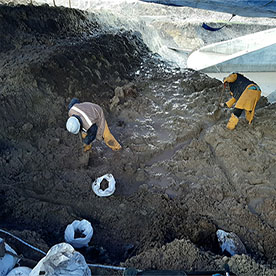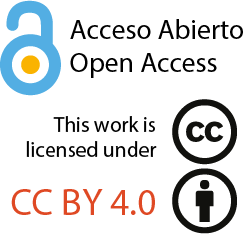METHODOLOGICAL PROPOSAL FOR PALEONTOLOGICAL EXCAVATIONS OF CONTINENTAL FOSSIL VERTEBRATES IN SMALL WET AREAS
DOI:
https://doi.org/10.5710/PEAPA.26.03.2023.445Keywords:
Paleontology, Excavation methodology, Paleontological rescue, Fossil vertebrates, Extraction of fossil vertebrates.Abstract
The aim of this article is to present a case study in the application of methodologies for the excavation of fossil vertebrate remains in restricted areas, within the framework of the environmental monitoring process in Chile. This study is of particular interest because it was carried out under high humidity conditions, during a period of approximately one month in which eight tons of sediment were processed. The applied methodology consisted in the manual excavation of fossiliferous levels through lateral clearing of horizontal planes with grids, from the upper levels to the base of the carrier stratum, with recovery of fossils through excavation of the layer and dry wrap. Additionally, the standard methodology for recovery of microvertebrates by washing and sieving was applied. The entire rescue process allowed the extraction of 82 paleontological pieces, of which 76% were recovered in situ, while 24% were recovered using the standard methodology. Based on the above, recommendations are offered to improve the methodological proposals for rescue and environmental monitoring, offering a comparative basis to evaluate the effectiveness of the techniques used in future rescue efforts.
References
Bisulca, C., Kronthal, L. y Davidson, M. (2009). Consolidation of fragile fossil bone from Ukhaa Tolgod, Mongolia (Late Cretaceous) with conservare OH100. Journal of the American Institute for Conservation,48:1, 37-50.
Brown, M. y Holliday, C. (2021). Non-traditional applications of fire in fossil preparation. Palaeontologia Electronica, 24(2): a22.
Cerda, I., Pereyra, M., Garrone, M., Ponce, D., Navarro, T., González, R., Militello, M., Luna, C., y Jannello J. (2020). A basic guide for sampling and preparation of extant and fossil bones for histological studies. Publicación Electrónica de la Asociación Paleontológica Argentina 20 (1): 15–28. http://dx.doi.org/10.5710/PEAPA.07.04.2020.314
Chechi, F. (2020). Algunas consideraciones sobre las técnicas de excavación arqueológica en obras de construcción. Práctica Arqueología (2): 1-13 (2019) ISSN: 2618-2874
Davidson, A. (2003). Preparation of a fossil dinosaur. Objects Specialty Group Postprints, Volume Ten, 2003 Pages: 49-61. Compilers: Virginia Greene, David Harvey, and Patricia Griffin. The American Institute for Conservation of Historic & Artistic Works, 1156 15th
Street NW, Suite 320, Washington, DC 20005. (202) 452-9545
Davidson, A. (2009). A mini-seminar on adhesives for fossil preparation. In: Methods In Fossil Preparation: Proceedings of the First Annual Fossil Preparation and Collections Symposium, pp 111- 122. Brown, M.A., Kane, J.F., and Parker, W.G. Eds.
Faegri, K. y Iversen, J. (1989). Textbook of pollen analysis. John Wiley & Sons Ld., Londres.
Brooks, S., Langdon, P. y Heiri, O. (2007). The Identification and Use of Palaearctic Chironomidae Larvae in Palaeoecology. QRA Technical Guide No. 10. Quaternary Research Association, London.
Fouquet, N., Mourgues, A., Oyanadel-Urbina, P.A. Chávez Hoffmeister, M. (2018). Consultoría: ¿Herramienta de financiamiento para la investigación paleontológica? I Congreso Chileno de Paleontología, Punta Arenas-Torres del Paine, Chile.
Frew, C. (2014). Coring Methods. In Cook, S., Clarke, L. y Nield, J. (eds) Geomorphological Techniques (Online Edition). British Society for Geomorphology, London.
Gallardo, F. y Cornejo, L. (1986). El diseño de la prospección arqueológica: un caso de estudio. Revista Chungara, N°16-17, 409-420.
Green, O. (2021). A manual of practical laboratory and field techniques in paleobilogy. Springer-Science, Business Medina, B.V.
Isasi, M. y Brissón, F. (2018). Técnicas paleontológicas. Ciencia Hoy, Asociación Civil, Ciencia Hoy.
Jiménez, F., Martin de Jesús, S. (1992). Sobre las técnicas de excavación paleontológica y sus variantes. Paleontología y sociedad, Sociedad Española de Paleontología y Departamento de estratigrafía y paleontología. Universidad de Granada. pp.113-119.
Melendi, D., Scafati, L., Volkheimer, W. y Chavez, R. (2009). Técnicas extractivas y preparativas en paleontología. Aspectos ambientales y de seguridad laboral. Revista del Museo Argentino de Ciencias Naturales, n.s.11(1).
Maltese, A. (2009). Difficult excavation and preparation of a large Daspletosaurus specimen. In: Methods in Fossil Preparation: Proceedings of the First Annual Fossil Preparation and Collections Symposium, pp 63-68. Brown, M, Kane, J y Parker, W. Eds.
Martel-Cea, A., Astorga, G., Hérnandez, M., Caputo, L., Abarzúa, A. (2021). Modern Chironomids (Diptera: Chironomidae) and the environmental variables that influence their dristribution in the Araucanian lakes, south-central Chile. Hidrobilogia. https://doi.org/10.1007/s10750-021-04575-0
Morín de Pablos, J., Malalana, A., Sánchez, I. (2014). Metodología arqueológica: Prospección, excavación, investigación, difusión y divulgación. en “Los paisajes culturales del Valle de Cigüela”. Ed. científico: Jorge Morín de Pablos. Auditores de Energía y Medio Ambiente S.A. Madrid.
LEY 17.288 (2019). De Monumentos Nacionales y Normas Relacionadas. 7° Edición. Consejo de Monumentos Nacionales.
Otero A., Pérez Moreno A., Falkingham, P., Cassini, G., Ruella, A., Militello, M. y Toledo N. (2020). Three-dimensional image surface acquisition in vertebrate paleontology: a review of principal techniques. Publicación Electrónica de la Asociación Paleontológica Argentina 20 (1): 1–14. http://dx.doi.org/10.5710/PEAPA.04.04.2020.310
Peterson, R., D´Andrea, N., Heckert A. (1999). The rondan jacket support clamp and jacket transport sled. New Mexico´s fossil record 2. Lucas S. ed. New Mexico Museum of Natural History and Science Bulletin No. 16.
Palacios, E. (2020). Guía de procedimientos arqueológicos. Consejo de Monumentos Nacionales, Ministerio de la Artes, Cultura y Patrimonio, Gobierno de Chile. 1a Edición.
Resolución Exenta N°650 (2022). Actualización de antecedentes profesionales para la obtención de permisos de intervención paleontológica y realización de trabajos en paleontología aplicada en materias de competencia del consejo de monumentos nacionales.
Reuil S., Muzzopappa, P. (2019). 3D Cast from natural molds: A case study in fossil frogs. Publicación Electrónica de la Asociación Paleontológica Argentina 19 (1): 1-6. http://dx.doi.org/10.5710/PEAPA.14.04.2019.280
Rincón, I., Gutstein, C. (2016). Guía de informes paleontológicos. Consejo de Monumentos Nacionales. Chile.
Russell, R. y Strilisky, B. (2016). Keep it together: An evaluation of the tensile strengths of three select adhesives used in fossil preparation. Collection Forum. 30 (1): 85-95. Society for the Preservation of Natural History Colletions.
SEA. (2012). Guía de Evaluación de impacto ambiental Monumentos Nacionales pertenecientes al patrimonio cultural en el SEIA. Editor: Servicio de Evaluación Ambiental. Diseño y Diagramación: Nicole Michel Aravena. ISBN: 978-956-9076-13-8.
Shávelzon, D. (2015). Manual de arqueología urbana: Técnicas para excavar Buenos Aires. Centro de Arqueología Urbana, Instituto de Arte Americano “M. J. Buschiazzo”, Facultad de Arquitectura, Diseño y Urbanismo, Universidad de Buenos Aires.
Whitlock, C. y Larsen, C. (2001). Charcoal as a proxy fire. In Smol, J., Birks H. y Last W. (eds) Tracking Environmental Change Using Lake Sediments: Terrestrial, Algal, and Siliceous Indicators. vol 3. Kluwer Academic Publishers, Dordrecht, The Netherlands, 75-97
Wright, H., Mann D. y Glaser, P. (1984). Piston corers for peat and lake sediments. Ecology 65:657–659.
Wylie, C. (2009). Preparation in action: paleontological skill and the role of the fossil preparator. In: Methods In Fossil Preparation: Proceedings of the First Annual Fossil Preparation and Collections Symposium, pp 3-12. Brown, M.A., Kane, J.F., and Parker, W.G. Eds.

Additional Files
Published
Issue
Section
License
Copyright (c) 2023 Jorge Campos-Medina, Martín Chávez-Hoffmeister, Pablo Oyanadel-Urbina, Jorge Bolomey-Badilla, Estefania Fernandez, Esteban Rodríguez, Carolina Sandoval, Matias González, Liz Vilches, Tomas Soto, Javiera Bravo

This work is licensed under a Creative Commons Attribution-NoDerivatives 4.0 International License.
Authors retain copyright and grant the journal right of first publication with the work simultaneously licensed under a Atribución/Reconocimiento 4.0 Internacional that allows others to share the work with an acknowledgement of the work's authorship and initial publication in this journal.















